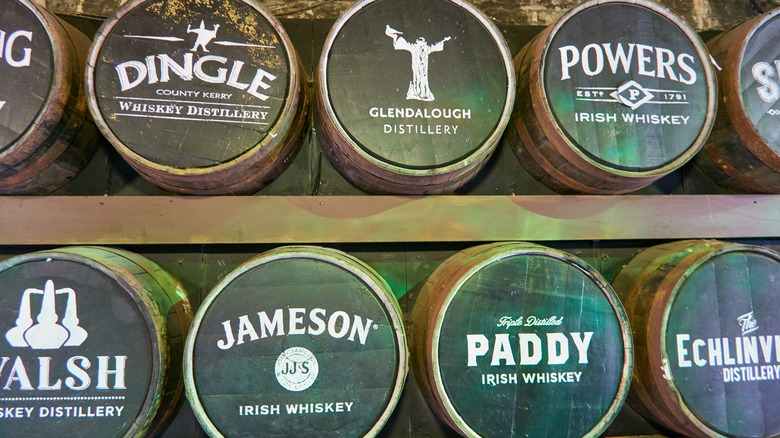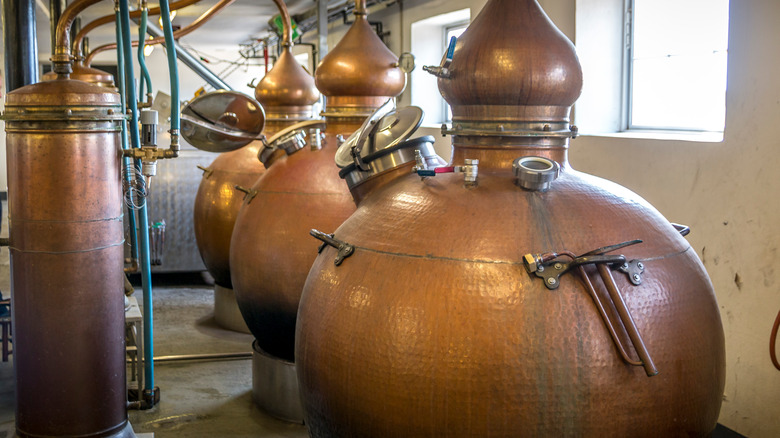What Makes Irish Whiskey The Real Deal
Irish whiskey has been around longer than nearly every other kind we know today. Though whiskey's concrete place of origin is debated, archeological evidence suggests that the spirit started in Ireland around the 1100s after distillation was introduced to the region by monks traveling from southern Mediterranean monasteries, according to Aleteia. A few centuries later, whiskey traveled to Scotland, where malting techniques honed the specific flavor profile that defined Scotch as a spirit and symbol of Scottish cultural identity (via Difford's Guide). Though whiskey has been traditionally associated with Ireland, generations of social and economic strife in Ireland made it challenging to cultivate a universally recognizable "Irish style" of whiskey until recent years.
In America, bourbon laws were developed not only to regulate quality for public safety but to ensure the product had American brand consistency, according to Distillery Trail. With Ireland's history of English occupation, traditional whiskey production had to accommodate obstacles caused by waves of tax acts and trade regulations. The 1785 Malt tax is one such piece of legislation that drastically impacted the character of Irish whiskey by taxing the ingredients (namely the malted barley necessary to make whiskey), which caused distillers to seek out mashing, distilling, and blending alternatives (via The Whiskey Library). These production variations eventually caused the Irish government to specify four different classifications for whiskey made in Ireland, each of which could be considered the real deal. But what makes one Irish whiskey more traditional or authentic than the others?
Standards and regulations
Generally speaking, all whiskey varieties that carry an "Irish whiskey" label must adhere to the 1980 Irish Whiskey Act, which formally defined Irish whiskey and created a standard for its production. Most importantly, it must be made and aged on the Emerald Isle, either in the Republic of Ireland or Northern Ireland. This stipulates that designation of Irish whiskey means the spirit must also include malted barley (or cereal grains) that's been fermented by yeast, distilled to a strength of no more than 94.8% ABV, and domestically aged for at least three years in wooden casks. Though these regulations are universal for all whiskeys produced in Ireland, classifications like pot still, malt, grain, and blended whiskey each come with their own additional production standards.
In terms of most traditional style, single malt Irish whiskey is the realest deal because it's theoretically the oldest given its similarity with traditional Scotch production methods (via Flaviar). According to Whiskey Advocate, a single malt must follow the state regulations and be made with 100% malted barley, produced at a single distillery using pot stills. Single grain whiskey is the least traditional of the Irish whiskeys, as it's usually made with alternative un-malted cereal grains like wheat or corn and is distilled in a column still rather than a pot still. This produces a spirit lighter in color and body, with a more consistent and floral flavor profile than single malt whiskey.
Pot still and the Irish identity
Ironically, the column (or Coffey still) was invented in Ireland to streamline whiskey production. Still, traditional Irish distillers refused to adopt the innovation and preferred the flavor that came with batching in pot stills (according to Flaviar). Though many commercial distilleries in America, Scotland, and Ireland have since switched to column stills, the soul of Irish whiskey is strongly associated with the pot still.
To circumvent the high taxes on malted barley, distillers started incorporating unmalted barley, which gave the whiskey a spicier, full-bodied, and fruitier character than its single malt and single grain siblings (via Vinepair).
According to Whiskey Advocate, to be labeled a single pot still, a whiskey must (in addition to Irish Whiskey Act requirements) be made in a single distillery with at least 30% malted barley and 30% un-malted barley, with no more than five percent additional cereals like oats or rye. The unmalted barley adds a dimension of spice (similar to rye) to the rich malt. The singular use of a pot still allows for the transference of more aromatic oils that impart body and flavor, creating a uniquely Irish spirit. So when it comes to identifying the "real" Irish whiskeys, look for labels like single pot still or single malt to try a whiskey shrouded in the cultural identity of Ireland.


